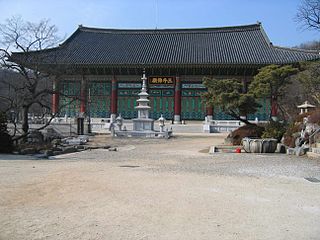 W
WBongwon Temple is a South Korean Buddhist temple in Bongwon-dong, Seodaemun-gu, Seoul, near Yonsei University.
 W
WThe Catholic Church in Korea is part of the worldwide Catholic Church, under the spiritual leadership of the pope in Rome.
 W
WThe Diocese of Chunchon is a particular church of the Latin Rite of the Roman Catholic Church in South Korea. A suffragan in the ecclesiastical province of the Metropolitan Archdiocese of Seoul, it has ecclesiastic authority over the administrative province of Gangwon-do.
 W
WChangchung Cathedral is the nominal cathedral of the Roman Catholic Bishop of Pyongyang, North Korea, located in the Changchung neighborhood of Songyo-guyok, Pyongyang. It is one of only four official Christian places of worship in Pyongyang. It operates under the Korean Catholic Association.
 W
WThe Christian Liberty Unification Party is a political party in South Korea established on March 3, 2016. Until 2020, it was known as the Christian Liberty Party (Korean: 기독자유당). Representatives of a range of Christian organizations including the Christian Council of Korea and the Communion of Churches in Korea attended the party's founding convention.
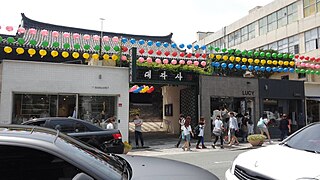 W
WDaegaksa is a Buddhist temple of the Jogye Order in Seoul, South Korea. It is located in Bongik 2-dong in the Jongno-gu area of the city.
 W
WGaeunsa is a Buddhist temple of the Jogye Order in Seoul, South Korea. Founded in 1396 it is located at 15 Anam 5-dong in the Seongbuk-gu area of the city.
 W
WGeumgoksa or Geumgok Temple (금곡사) is a Buddhist temple in Gangjin county, South Jeolla province, South Korea. Its name means "Golden Valley Temple." Three temples and numerous smaller shrines and burial mounds comprise the site. It is noted for its scenic beauty as well as a 3-tiered stone pagoda that dates to the Goryo Dynasty.
 W
WGeumseonsa is a Buddhist temple of the Jogye Order in Seoul, South Korea. Believed to have been established before 1405 it is located in 196-1 Gugi-dong in the Jongno-gu area of the city.
 W
WGwaneumsa (관음사) is a Buddhist temple of the Jogye Order in Seoul, South Korea. Believed to have been established in 895, it is located in 519-3 Namhyeon-dong in the Gwanak District of the city.
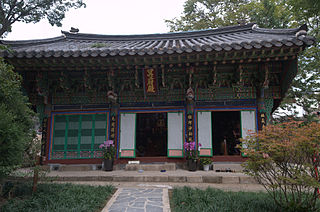 W
WHeungcheonsa is a Buddhist temple of the Jogye Order in Seoul, South Korea. It is located at 592 Donam-dong, in the Seongbuk-gu area of the city.
 W
WInwangsa is a Buddhist temple of the Bonwon Order in Mt. Inwangsan, Seoul, South Korea. It is located at San 2 Muak-dong, in the Jongno-gu area of the city. When King Taejo of Joseon Dynasty established the capital city in Seoul, he assigned Josaeng, a monk from a Buddhist temple affiliated to the royal court as the head monk of the new temple to establish it at the site.
 W
WA jangseung or village guardian is a Korean totem pole usually made of wood. Jangseungs were traditionally placed at the edges of villages to mark for village boundaries and frighten away demons. They were also worshipped as village tutelary deities.
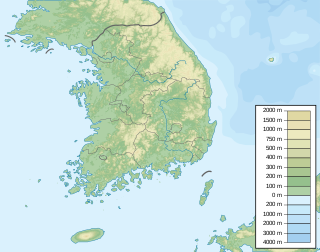 W
WThe Jeju Islamic Cultural Center or Jeju Islamic Center is an Islamic cultural center in Nohyeong, Jeju City, Jeju Province, South Korea.
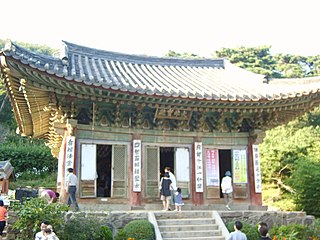 W
WJeondeungsa is a Buddhist temple located in Ganghwa-gun, Incheon, South Korea.
 W
WThe Our Lady of Lourdes Cathedral or simply Cathedral of Daegu, is a religious building belonging to the Catholic Church and is located in Daegu part of North Gyeongsang Province, South Korea.
 W
WPagyesa, or Pagye Temple, is a Buddhist temple in Palgongsan mountain park, near Daegu, South Korea. The temple was first built in 804 by a priest named Simji, and was restored and expanded in the 17th century.
 W
WThroughout the ages, there have been various popular religious traditions practiced on the Korean peninsula. The oldest indigenous religion of Korea is the Korean folk religion, which has been passed down from prehistory to the present. Buddhism was introduced to Korea from China during the Three Kingdoms era in the 4th century, and the religion pervaded the culture until the Joseon Dynasty, when Confucianism was established as the state philosophy. During the Late Joseon Dynasty, in the 19th century, Christianity began to gain a foothold in Korea. While both Christianity and Buddhism would play important roles in the resistance to the Japanese occupation of Korea in the first half of the 20th century, only about 4% of Koreans were members of a religious organization in 1940.
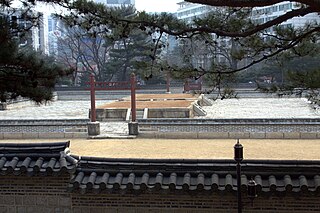 W
WThe Sajikdan is a Korean Neo-Confucian altar located in Seoul, South Korea used to perform the national soil and grain ceremonies during the Joseon Dynasty.
 W
WSanshin or Sansin are local mountain-spirits in Korean Shamanism and folk-beliefs. In South Korea, most Buddhist temples and major Shamanic-shrines, and some traditionalist villages have a dedicated shrine called a sanshin-gak or an altar called a sanshin-dan dedicated to the local sanshin. This nature-deity is typically represented in the enshrined icons as an elder male figure in royal-Confucian clothing, always accompanied by at least one tiger and a Korean Red Pine tree. There are many other symbols being held by the Sanshin, offered to him by servants or in the backgrounds of the more elaborate paintings, derived from Oriental Daoism, Buddhism, Neo-Confucianism, shamanic-folklore and Korean 'spiritual-ethnic nationalism' -- making these multi-religious icons unique in the entire world.
 W
WSŏngbul-sa is a Korean Buddhist temple in Sariwŏn, North Hwanghae Province, North Korea. It is located within the castle on Mt. Jŏngbang and was founded in 898 AD. The temple consists of six buildings, some of which are among the oldest wooden buildings in North Korea.Kukrak Hall (극락전/極樂殿). Rebuilt in 1374, this pavilion sits on a raised stone platform and features delicate paintings, cow-tongue eaves, and doors with carved flower grilles. A Koryo period five-story stone pagoda stands in front of it. Ungjin Hall (웅진전/雄津殿). Rebuilt in 1327, Ungjin Shrine is one of the oldest wooden buildings in North Korea. The long, spacious hall sits on a raised platform, and is a paradigm of Koryo architecture. Myŏngbu Hall (명부전/冥府殿) Chongpung Pavilion (청풍루/清風樓) Unha Hall (운하당/雲霞堂) Sansin Shrine (산신각/山神閣)
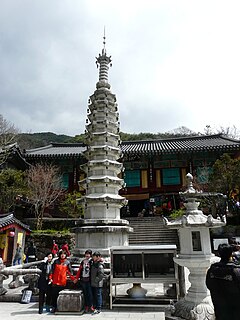 W
WSsanggyesa is a head temple of the Jogye Order of Korean Buddhism. It is located on the southern slopes of Jirisan, southwest of sacred Samshin-bong Peak, in the Hwagye-dong Valley of Hwagae-myeon, Hadong County, in the province of Gyeongsangnam-do, South Korea.
 W
WSt. Paul's Cathedral, also known as Incheon Cathedral and Dapdong Cathedral, is a Roman Catholic Cathedral located in Incheon, South Korea's third largest City.
 W
WSunmudo is a Korean Buddhist martial art based on Seon, which was revived during the 1970s and 1980s. The formal name of Sunmudo is Bulgyo Geumgang Yeong Gwan. The name Sunmudo was given to this martial art in 1984 by the Buddhist monk Jeog Un.
 W
WThe Tabo Pagoda of the Pohyonsa Buddhist temple located at Mt. Myohyang, Hyangam-ri, Hyangsan County, North Phyongan Province, North Korea. It is listed as a National Treasure of North Korea. A one-third model of the Pagoda is on display at the Korean Central History Museum.
 W
WThe Diocese of Uijeongbu, also romanized Uijongbu, is a particular church of the Latin Rite of the Roman Catholic Church in South Korea. It is the newest diocese in South Korea, erected from the Archdiocese of Seoul on June 24, 2004 by the orders of Pope John Paul II, and a suffragan diocese of the same. Its mother church is the Cathedral of the Sacred Heart of Mary in Uijeongbu, Gyeonggi-do.
 W
WThe Anak Woljongsa is an historic Buddhist temple, one of the National Treasures of North Korea (#75). It is located in Woljong-ni, Anak County, South Hwanghae Province. It is located near Mt. Kuwol.
 W
WWonga Temple or Wongaksa is a South Korean Buddhist temple on the Geumnam street in the Dong-gu district, Gwangju city. Situated in the downtown of the metropolitan city, this is a branch temple of the Songgwang temple in Suncheon and belongs to the Jogye Order of Korean Buddhism. It was founded in 1914 by Master Geumbong Girim (錦峯基林) of Seonam temple as its missionary center in Gwangju.
 W
WYujŏm-sa is a Korean Buddhist temple located on Mount Kumgang, North Korea. Founded under the kingdom of Silla, it underwent many successive restorations before being destroyed by American forces during the Korean War.